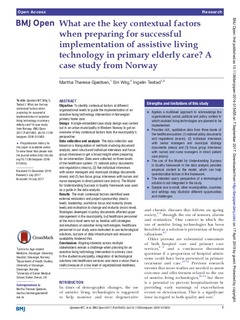| dc.contributor.author | Gjestsen, M.T. | |
| dc.contributor.author | Wiig, S. | |
| dc.contributor.author | Testad, I. | |
| dc.date.accessioned | 2019-04-17T10:40:52Z | |
| dc.date.available | 2019-04-17T10:40:52Z | |
| dc.date.issued | 2017 | |
| dc.identifier.citation | Gjestsen, M. T., Wiig, S., & Testad, I. (2017). What are the key contextual factors when preparing for successful implementation of assistive living technology in primary elderly care? A case study from Norway. BMJ Open, 7(9), e015455. | nb_NO |
| dc.identifier.uri | http://hdl.handle.net/11250/2594914 | |
| dc.description.abstract | Objective: To identify contextual factors at different organisational levels to guide the implementation of an assistive living technology intervention in Norwegian primary home care.
Design: A single embedded case study design was carried out in an urban municipality in Western Norway to get an overview of key contextual factors from the municipality’s perspective.
Data collection and analysis: The data collection was based on a triangulation of methods involving document analysis, semi-structured individual interviews and focus group interviews to get a broad insight when preparing for an intervention. Data were collected on three levels of the healthcare system: (1) national policy documents and regulations (macro), (2) five individual interviews with senior managers and municipal strategy documents (meso) and (3) two focus group interviews with nurses and nurse managers in direct patient care (micro). The Model for Understanding Success in Quality framework was used as a guide in the data analysis.
Results: The main contextual factors identified were external motivators and project sponsorship (macro level); leadership, workforce focus and maturity (meso level);and motivation to change and maturity (micro level). Strategies developed in policy documents affected upper management in the municipality, but healthcare personnel at the micro level were not so familiar with strategies and emphasis on assistive living technologies. Healthcare personnel in our study were motivated to use technological solutions, but lack of data infrastructure and resource availability hindered this.
Conclusions: Aligning interests across multiple stakeholders remain a challenge when planning for an assistive living technology intervention in primary care. In the studied municipality, integration of technological solutions into healthcare services was more a vision than a reality because of a low level of organisational readiness. | nb_NO |
| dc.publisher | BMJ Open | nb_NO |
| dc.rights | Navngivelse-Ikkekommersiell 4.0 Internasjonal | * |
| dc.rights.uri | http://creativecommons.org/licenses/by-nc/4.0/deed.no | * |
| dc.subject | implementation | nb_NO |
| dc.subject | assistive living technology | nb_NO |
| dc.subject | elderly care | nb_NO |
| dc.subject | key contextual factors | nb_NO |
| dc.subject | Norway | nb_NO |
| dc.subject | velferdsteknologi | nb_NO |
| dc.title | What are the key contextual factors when preparing for successful implementation of assistive living technology in primary elderly care? A case study from Norway | nb_NO |
| dc.type | Journal article | nb_NO |
| dc.source.pagenumber | e015455 | nb_NO |
| dc.source.volume | 7 | nb_NO |
| dc.source.journal | BMJ Open | nb_NO |
| dc.source.issue | 9 | nb_NO |
| dc.identifier.doi | http://dx.doi.org/10.1136/bmjopen-2016-015455 | |

